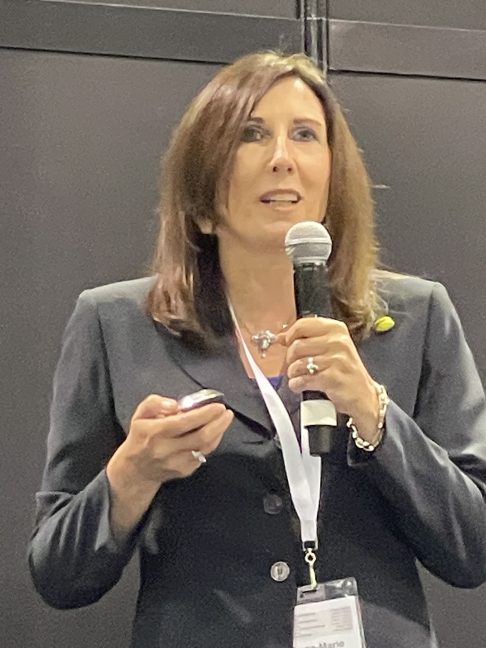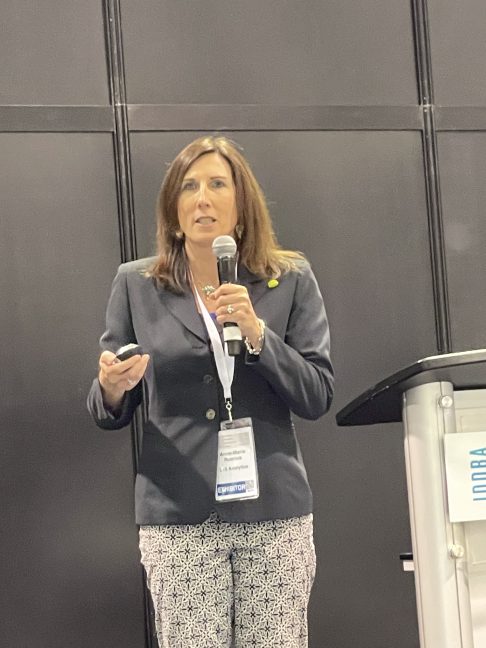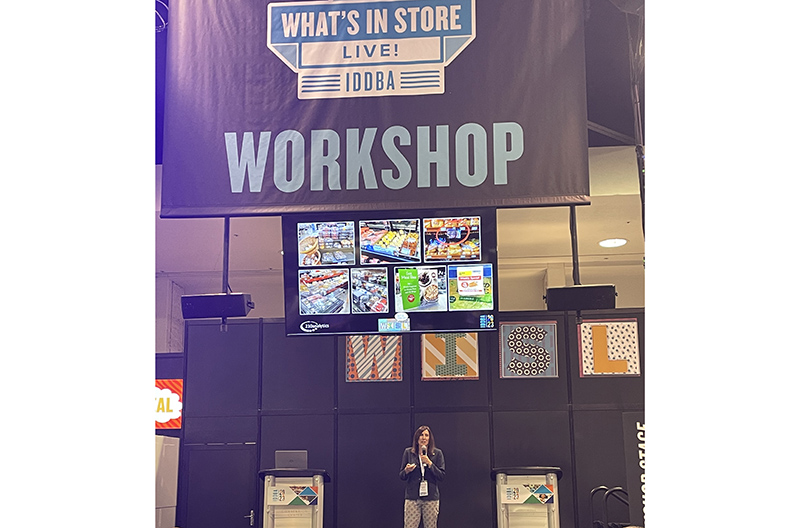“We see daily deals, we see weekend deals, we see all these different ways to engage with people in different time periods.” This is how Anne-Marie Roerink, principal at 210 Analytics LLC, began her presentation at the What’s In Store Live stage June 5 at the IDDBA Show in Anaheim, California.
Titled “Global Store Tours: Merchandising Ideas Ripe For The Picking From Retailers Around World,” the presentation examined how supermarkets can begin to fight back as supercenters, club stores and online marketplaces have taken three to five share points of the total market.
“A lot comes down to value in the marketplace…When we talk to consumers about that, pretty much everything in their shopping habits has changed. When you have eight in 10 consumers who are looking to change where they buy, what they buy, what brands they buy, that is a lot of risks if you are a brand.”
This type of change in the marketplace opens up a new way to engage customers. Creativity is becoming more and more important. Retailers learning how to vary their promotional strategies, engage consumers in more meaningful ways and learn from each other will begin to take back market share.

“If you think about where did we come up with the deals and promotions? It’s typically, ‘Well, what was on sale the same week last year,’ right? Now what we’re seeing is we may not be able to promote that heavily during that entire week.”
Roerink gave two examples of time-specific promotions. One featured a sale of prepared ribs only available on Fridays by Thibodaux, Louisiana-based Rouses Supermarket.
“Maybe now we really become known for ribs on Friday, so that when (consumers) are in the mood for those ribs, they know they’re going on sale at Rouses on Friday.”
She continued with an example from Asheville, North Carolina-based Ingles Markets, which featured “donut happy hour.” Ingles Advantage members can pick any three donuts out of the self-service case between 6 p.m. and close for only 99 cents.
“How smart is that? Because you have to toss them out at the end of the evening anyway. Now you can make people feel good and maybe drive an extra trip. Being known for something and having a reputation in a certain meal, that really is important, especially if you can tie it back to the daily specials.”
According to data gathered by 210 Analytics, 76 percent of shoppers are interested in daily specials.
Mix-and-match promotions continue to show promise. Roerink showcased a retailer in Australia that promoted mix-and-match bakery items. This, along with cross-departmental promotions, continues to succeed in market areas around the world.
She continued speaking about the European grocery market, and how it is quickly adjusting prices electronically based on outside phenomena. A strategy known as “dynamic pricing” is being tested in markets around Europe. The technique allows retailers to electronically change pricing quickly to adapt to any situation.
“Depending on time of day that you’re buying, they can move those prices up and down using electronics. For instance, the example this retailer gives a lot is they were expecting favorable weather, so they really stocked up on items for the grill. All of a sudden, a storm rolled in that nobody was expecting. Nobody is going to grill. They’re able to adjust those prices to still move that product.”
Retailers need to connect with more of their customers in new and exciting ways. She gave examples related to price matching, digital advertising and couponing and topical pricing.
One retailer in Europe was competing directly with another large retailer by implementing a price match guarantee in its meat department.
Advertising based on fuel promotions is also extremely important.
“Gasoline prices actually have the biggest influence on consumer behavior.”
Roerink cited another European retailer who was offering 15 cents off per gallon when purchasing fresh salads from the full-service deli case.
Much like gasoline pricing, digital experiences continue to be important. An Australian retailer is utilizing digital advertising with a Low Price unlock.
She gave an example of a low-price print advertisement in store for water. When customers purchase the specially-marked water and scan the accompanying QR code, they get access to other deals around the store.
“Especially if you are a CPG company that is active in multiple areas, what a great way to alert people to some of the other specials that are out in the marketplace.”
Likewise, personalization in that digital experience is important. Roerink said this comes with a variety of benefits.
“We all know the cost of paper is high. The circulation of papers, especially in smaller markets, is becoming harder and harder. But the one thing you cannot do is buy in the email list. So, as it relates to communicating with people digitally…we have the maximum number of people who are looking for promotions and prices. We leverage those departments where we see a high level of promotional research, which is meat, produce. We leverage those departments to get people involved with those digital deals where they have to download the app, or they have to share their email. The idea of personalized coupons and personalized promotions is incredibly popular.”
General digital promotional flyers get about a 1 percent click-through rate. Conversely, personalized digital coupons get an average click-through rate of 12-14 percent.
Retailers need to answer that digital experience with loyalty. Many have already implemented their own loyalty programs. Roerink said retailers need to take advantage of customers’ online interactions and continue to expand the offerings into individual departments.
“As you all know, if you go to Starbucks 10 times, you get a free cup of coffee…Now what we’re seeing within store departments is that they’re actually starting to drive that same concept: Buy 10 doughnuts, get one free. Get 10 salads on our loyalty program, get one free. The idea of closing that intersection and driving frequency is incredibly important. Because, at the end of the day, it is so much harder to convert somebody that has never engaged with your category or never engaged with your store or your product than it is to drive the frequency of somebody who is engaged with you.”
Value continues to be the No. 1 driver for customers during inflationary periods, but according to 210 Analytics data, shoppers feel the need to splurge on “special occasions and holidays, if it is a brand they like or want to do something nice for themselves or loved ones.”

These were the top three reasons customers splurge.
Other reasons include:
- Convenience
- Healthier
- Time
- Replacing restaurant meal
- More sustainable, humanely or ethically produced
Celebrating a personal special occasion is the highest “splurge-inducing” reasoning in retail, Roerink said. Likewise, celebrating special personal occasions, such as birthdays or anniversaries, is the third-highest reason consumers splurge. These personal events beat out major holidays such as Father’s Day, Easter and Valentine’s Day.
Retailers need to capitalize on this, Roeink said.
She gave an example of a U.K. retailer that gave 20 percent off birthday cakes if customers prove it is their birthday.
Likewise, consumers need to celebrate unofficial holidays.
“If we can’t have an official one, we can always invent some, and that’s really where some of these national holidays come from. Whether it’s National M&M Day, Grilled Cheese Day, you name it. Also, be creative.”
She gave an example of a retailer who had made a cake in the shape of a watermelon to celebrate Nation Watermelon Day.
“There is always a moment, and we can create occasions out of all of that.”
Roerink gave more examples of ordinary moments “made extraordinary.” Moments such as Hostess’ “Tasty Study Break” around exam times for college towns; the FIFA World Cup, which is growing in popularity around the U.S.; local sports events; and even the release of a new gaming console, which typically drives snack and beverage sales.
She then gave a personal anecdote of the way snacking and community involvement are driving sales.
“I remember a friend of mine had a son in college and all the parents were sent a letter from the college that said you can order a snack basket – it was exam week – and ‘oh, for $50, we can deliver this to his dorm room.’ It was basically a couple of bags of snacks, but they were creating the occasion.”
For more information about the show, click here.
To read more marketing news from The Shelby Report, click here.

